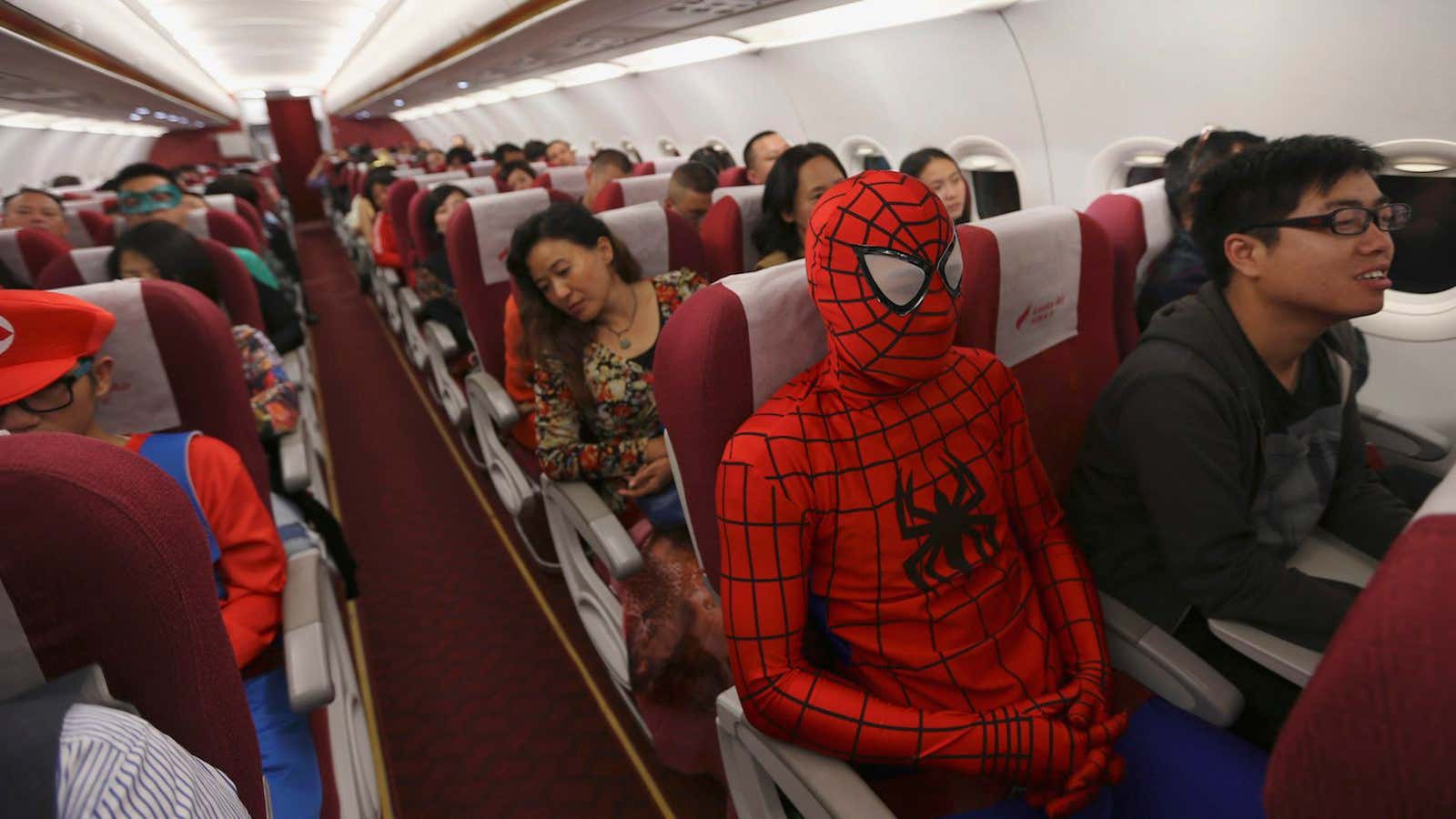You think it will never happen to you. You’re pretty sure you know where the nearest exit is, what the escape path lighting looks like, and how to put your airmask on, but you don’t think you’ll ever need to use this information. So why sit through a refresher every time you board a plane?
Reminding customers what to do in an emergency without causing panic—but without putting anyone to sleep—is a delicate job. For some years now, jaded passengers have been hiding behind their newspapers and fiddling with their smartphones (not always in flight-mode) as wearyingly chirpy cartoon characters show off life vests, or as real-life staff suffered the humiliation of the donning of the life-vest routine: “Blow into this little tube,” “pull the red toggle,” and the grande finale, a double-handed karate-chop for “forward,” “over the wings,” and “to the rear of the aircraft.”
Now, at last, there is a new brand communications paradigm across the wider airline industry: Companies worldwide are adopting a more immersive and cinematic approach to the safety briefing, using a visual lexicon borrowed from the world of the movies.
Making safety look good
Icelandair, for example, draws on breathtaking panoramic vistas to create a video that captures nature-lovers’ attention as it communicates safety instructions. When showing passengers the escape path lighting, there is visual reference to the Northern Lights. During the inevitable part about jumping down inflatable slides, there’s a scene with a couple jumping into a lagoon—the slide superimposed on the vista.
“After looking at various other safety videos, we came to the conclusion that by highlighting Icelandic nature, we would encourage the viewer to watch the video,” explained Ragnar Jónsson, creative director of Reykjavik-based Islenska, the agency behind Icelandair’s safety video, to Quartz. “Not least because connecting nature and safety isn’t a theme that surfaces often in the aviation industry.”
On the other side of the world, Air New Zealand recently went pop instead of placid, enlisting the “Men in Black” to lend a hand in its own safety video. Rip Torn from the original MIB blockbuster franchise reprises his role as the grouchy chief, but for Kiwis, Black is a brand value associated with the national rugby team, so the “All Blacks” participate as well.
All Blacks’ captain Richie McCaw and Dan Carter, coach Steve Hansen, and teammates Kieran Read, Keven Mealamu, Sam Whitelock, and Israel Dagg star in the pre-flight safety briefing attired in black suits and shades—just like the characters once played by Will Smith and Tommy Lee Jones.
“We recently extended our sponsorship of the All Blacks and New Zealand Rugby through until 2020 and thought what better way to celebrate than with a safety video,” the airline’s head of brand development, Jodi Williams, explained to Quartz. “The result is not only entertaining but makes people sit up and take notice of the key safety messages.”
Air New Zealand’s previous safety blockbuster was the Hobbit-themed “Most Epic Safety Video Ever Made” starring Elijah Wood and Sir Peter Jackson.
Although inspired by a different era, Air France too recently took a cinematic approach to its pre-flight safety movie. The airline admits it took its cues in part from the French New Wave cinema of the 1950s and ’60s. Ulli Gendrot, the airline’s international media relations manager, told Quartz that French director Jacques Demy’s movie Les Demoiselles de Rochefort was an inspiration.
Anything to be different
Brand differentiation is without doubt the driving motivation: In the increasingly commoditized airline sector, the Internet has given consumers unprecedented empowerment when shopping for the most competitive airfares—passengers are better informed about the choices available, via the airlines’ own websites and reinforced by the social media channel.
But when there’s negligible financial difference between those options, emotions hold sway as to which airline brand they’ll click on. Creating a sense of authenticity and an experience that is uniquely French, Icelandic, or even New Zealander, in the case of the three aformentioned national airlines, is a refreshing alternative to generic corporate branding, and a smart use of a captive audience.
What’s common to all three airlines’ safety videos are strong visual and graphic colour palettes that reflect national heritage—the red, white and blue tricolore outfits of the Air France flight attendants, the Men In Black suits mirroring the rugby kit of New Zealand’s All Blacks, and in the case of Icelandair it’s the subtle ethereal blue and white landscape with a dash of red, courtesy of the pyrotechnics of the Northern Lights. It’s a case of “flying the flag.”
The new inflight experience
Another factor, of course, is the strong symbiosis between the safety film and a better flying experience. The swish of the curtains in Air France’s film, for example, mirrors the company’s differentiated cabin ambience—unlike other airlines which segregate premium customers with solid partitions, Air France really does use curtains. It’s all part of an industry-wide shift in values, reflected at least in part in customer-friendly entertainment.
“The brief given by Air France to the creative agency BETC was quite simple: Create a video that our passengers will actually watch (because safety is a priority), respect all the mandatory/legal items, tell a story about who we are (a French airline), create a video that will live outside of our aircraft and that will outline our new positioning,” Ulli Gendrot told Quartz.
By “new positioning,” she was referring to the airline’s recent focus on customer experience, initiated three years ago with new investments in cabins and in-flight dining. At altitudes of more than 30,000 feet, competing for cushiest cabin time still means safety first.
